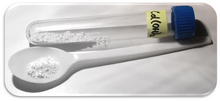Informatics Educational Institutions & Programs
Contents

| |

| |
| Names | |
|---|---|
| IUPAC name
Cadmium(II) hydroxide
| |
| Identifiers | |
3D model (JSmol)
|
|
| ChemSpider | |
| ECHA InfoCard | 100.040.137 |
PubChem CID
|
|
| UNII | |
CompTox Dashboard (EPA)
|
|
| |
| |
| Properties | |
| Cd(OH)2 | |
| Molar mass | 146.43 g/mol |
| Appearance | white crystals |
| Density | 4.79 g/cm3 |
| Melting point | 130 °C (266 °F; 403 K) |
| Boiling point | 300 °C (572 °F; 573 K) (decomposes) |
| 0.026 g/100 mL | |
Solubility product (Ksp)
|
7.2×10−15 [1] |
| Solubility | soluble in dilute acids |
| -41.0·10−6 cm3/mol | |
| Structure | |
| hexagonal | |
| Thermochemistry | |
Std molar
entropy (S⦵298) |
96 J·mol−1·K−1[2] |
Std enthalpy of
formation (ΔfH⦵298) |
−561 kJ·mol−1[2] |
| Hazards | |
| NIOSH (US health exposure limits): | |
PEL (Permissible)
|
[1910.1027] TWA 0.005 mg/m3 (as Cd)[3] |
REL (Recommended)
|
Ca[3] |
IDLH (Immediate danger)
|
Ca [9 mg/m3 (as Cd)][3] |
| Related compounds | |
Other anions
|
Cadmium chloride, Cadmium iodide |
Other cations
|
Zinc hydroxide, Calcium hydroxide, Magnesium hydroxide |
Except where otherwise noted, data are given for materials in their standard state (at 25 °C [77 °F], 100 kPa).
| |
Cadmium hydroxide is an inorganic compound with the formula Cd(OH)2. It is a white crystalline ionic compound that is a key component of nickel–cadmium battery.[4]
Structure, preparation, and reactions
Cadmium hydroxide adopts the same structure as Mg(OH)2, consisting of slabs of octahedral metal centers surrounded by octahedral of hydroxide ligands.[5]
It is produced by treating cadmium nitrate with sodium hydroxide:
- Cd(NO3)2 + 2 NaOH → Cd(OH)2 + 2 NaNO3
Preparation has been achieved from some other cadmium salts,[6][4]
Cd(OH)2 and cadmium oxide react equivalently. Cadmium hydroxide is more basic than zinc hydroxide. It forms the anionic complex [Cd(OH)4]2− when treated with concentrated base. It forms complexes with cyanide, thiocyanate, and ammonia.
Cadmium hydroxide loses water on heating, producing cadmium oxide. Decomposition commences at 130 °C and is complete at 300 °C. Reactions with mineral acids (HX) produce the corresponding cadmium salts (CdX2). With hydrochloric acid, sulfuric acid, and nitric acid, the products are cadmium chloride, cadmium sulfate, and cadmium nitrate, respectively.
Uses
It is generated in storage battery anodes, in nickel-cadmium and silver-cadmium storage batteries in its discharge:
- 2 NiO(OH) + 2 H2O + Cd → Cd(OH)2 + 2 Ni(OH)2
References
- ^ John Rumble (June 18, 2018). CRC Handbook of Chemistry and Physics (99 ed.). CRC Press. pp. 5–188. ISBN 978-1138561632.
- ^ a b Zumdahl, Steven S. (2009). Chemical Principles 6th Ed. Houghton Mifflin Company. p. A21. ISBN 978-0-618-94690-7.
- ^ a b c NIOSH Pocket Guide to Chemical Hazards. "#0087". National Institute for Occupational Safety and Health (NIOSH).
- ^ a b Karl-Heinz Schulte-Schrepping, Magnus Piscator "Cadmium and Cadmium Compounds" in Ullmann's Encyclopedia of Industrial Chemistry, 2007 Wiley-VCH, Weinheim. doi:10.1002/14356007.a04_499.
- ^ Hemmingsen, L.; Bauer, R.; Bjerrum, M. J.; Schwarz, K.; Blaha, P.; Andersen, P., "Structure, Chemical Bonding, and Nuclear Quadrupole Interactions of β-Cd(OH)2: Experiment and First Principles Calculations", Inorganic Chemistry 1999, volume 38, 2860-2867. doi:10.1021/ic990018e
- ^ F. Wagenknecht; R. Juza (1963). "Cadmium hydroxide". In G. Brauer (ed.). Handbook of Preparative Inorganic Chemistry, 2nd Ed. Vol. 2. NY, NY: Academic Press. p. 1096.

















